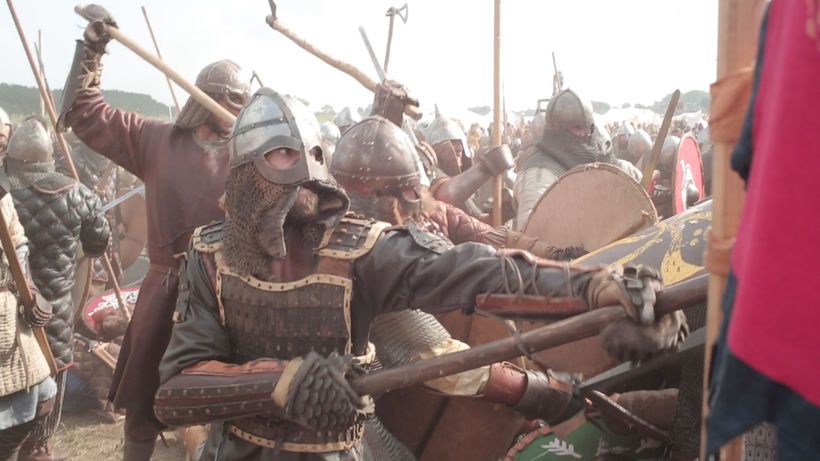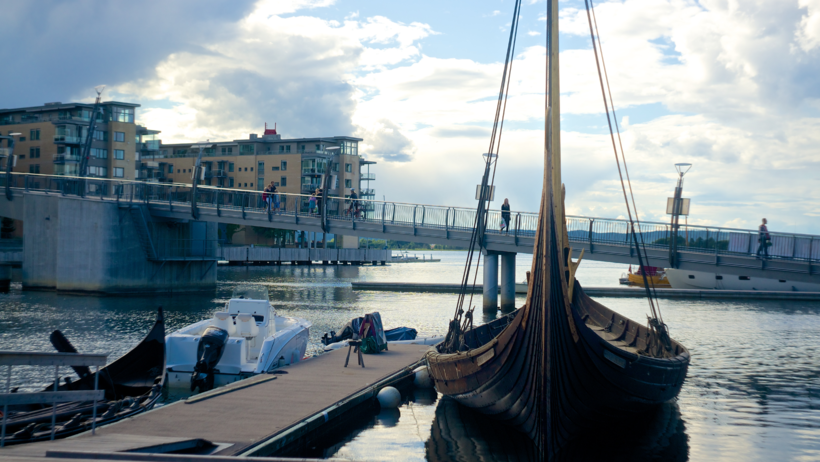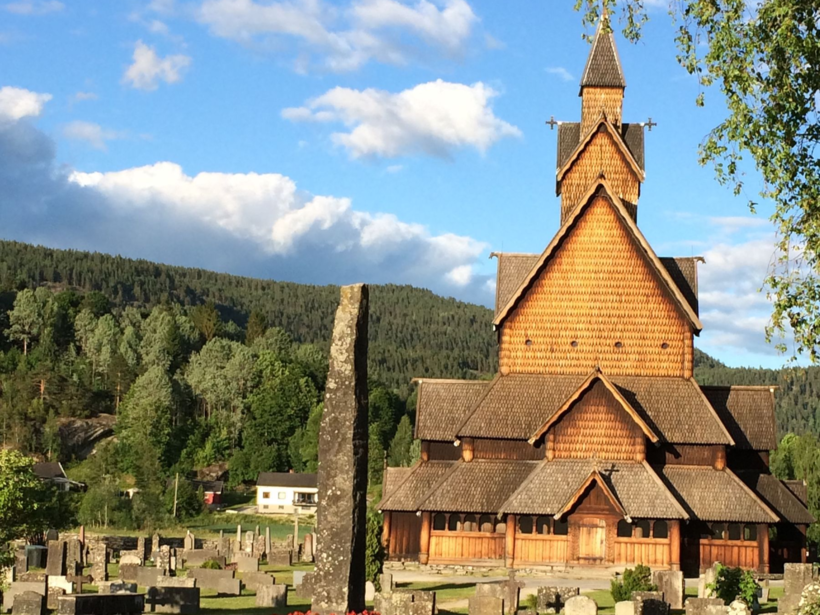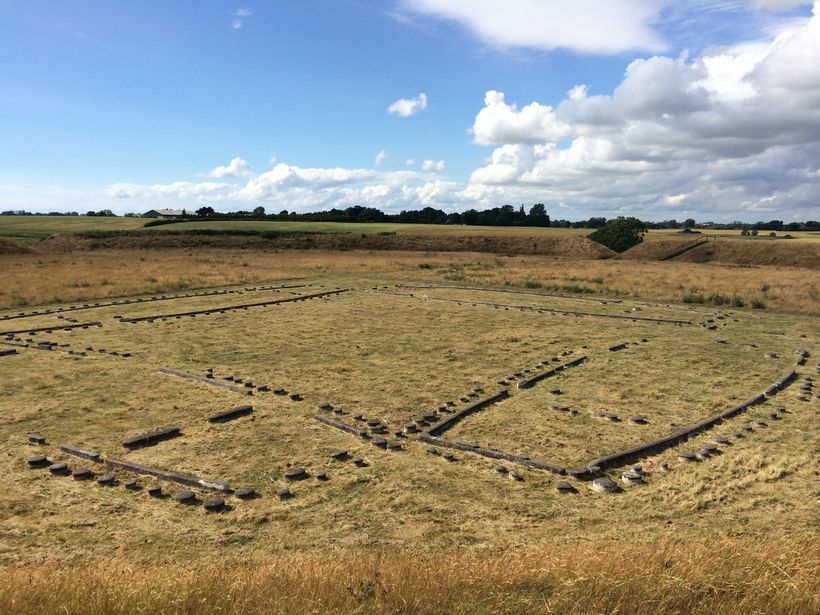The Vikings
Stories of epic heroes and real ways of life mingle in this stunning series on the Vikings.
They were bloodthirsty Scandinavian warriors and fine craftsmen. They opened trade routes, founded cities and captured ancient hubs. The Saxons of England feared them but mocked their careful grooming habits. In short, they were pirates with style. This series follows the Vikings everywhere they went, revealing new discoveries that turn Viking history on its head. We tell their incredible story from eye-witness accounts and the foremost experts on Viking warfare and way of life.
Their kings had names such as Svien Forkbeard or Eirik Bloodaxe, their ships plied the seas and rivers of half the globe. They were the Vikings. From Newfoundland to the Caspian Sea they robbed and traded fine furs and jewelry, slaves and weapons: anything that was worth something. The Viking era is the last of the great periods of barbarian attacks. It left Europe transformed, ripe for the rise of the new nations that marked the middle ages. Norsemen, another word for Vikings, conquered a quarter of France, half of England and a third of Italy. They served as bodyguards to emperors in Constantinople while they pushed the frontiers of trade into Asia, exchanging walrus ivory and amber, furs and slaves for the fine gold and precious stones from southern lands. Their original homeland was the windswept north of Europe, the ragged and rocky fjords of Norway, the dark forests of Sweden and the bleak lowlands of Denmark.
The series describes the Viking way of life, in which pillage was just one many activities. Vikings grew crops, raised cattle, wove splendid cloth, carved wood and stone, and traded in the best weapons. Their military technology was advanced – they built the first ever landing ships for their raids on England, their steel was better than any other, their hit-and-run tactics were invincible. Wherever they went, they spread terror and they ruled the lands they conquered with an iron fist.
Episodes
-
Viking Dawn
"The first episode of the series tells the story of how the Viking epic began. Bloodthirsty and warlike tribes had always inhabited the northern parts of Europe. The Romans had come across them and described them, such as the Cimbri who took prisoners only to sacrifice them to the gods; Nordic Goths and Longobards and Burgundians were among the barbarian hordes that killed the Empire. The recounting of these early barbarians is but a taste of more adventure to come. We tell the legendary origins of the Nordic race, through the myths shared by Danes, Norwegians and Swedes, a mix of tribes and petty kingdoms that stretched from the frigid North Sea to the icy beaches of the Baltic. Their social structure and their religion is known to us, through the epic tales reported by authoritative sources such the Frankish and Anglo-Saxon Chronicles. We examine their religion: warrior gods, Wotan and Thor, fertility goddess Frey and goddess of the Underworld Hel. We describe the death rituals and the yearning for Valhalla. We also look for the first time at several of the legendary Viking heroines, such as Broka Aubur, who attacked her unfaithful husband with a sword and defied social tradition by wearing trousers, or Gudrid Porbjarnadottir, helped lead the third Viking expedition to America in the 11th century. They are among a handful of forceful women in the Viking sagas, stories that modern feminists now believe set the stage for the strong position many women hold in the Nordic region today. We interview a number of leading medieval scholars about several outstanding Viking heroines, recount how they gained power and analyse the stamp it left on modern European society. "
-
Viking Weapons
"This episode covers the way the Vikings developed the tools of their trade. Pillage was a spare-time occupation but (alongside trade - and at times the two went together) proved to be exceptionally profitable. Plundering the coasts of France or England could of course be quite risky so the Vikings developed weapons and tactics to heighten the effect of surprise. Nothing would have been possible without the Viking ship. We examine the development of the longboat, the typical Viking ship, with its broad beam and shallow keel, able to sail up rivers but at the same time take to the high seas, bending with the waves thanks to the clinker build (outer boards laid partially one on top of the other) and joints made with wooden pegs. The Viking ships were able to sail close to the wind, making them faster and more versatile than any enemy vessel and were equipped with oars so as to manoeuver when there was no wind. Viking steel was the best of its age. It was developed to make weapons of war. Remains of Viking weapons, although relatively rare, show a high level of craftsmanship. The Viking warrior carried not only a sword but also an axe. The battle-axe was one of the characteristic weapons of the Norsemen and could effectively cut through helmet and chain mail. "
-
Raiders and Explorers
The map of the western hemisphere shows no place untouched by Viking explorers. Following the coastline of Norway into the Arctic sea, traders in Walrus tusks and whale fat explored the arctic wastes bringing rich wares home to trade in the marts of Birke and Hedeby. These were the rich northern routes the Kings of Denmark coveted when they claimed Norway as theirs. On the other hand, Viking sailors pillaged and plundered the rich Irish coastline, taking slaves to Iceland where they would serve on the barren uplands as shepherds. Pushing out further still the Vikings headed west, founding Greenland and west even further, under Leif Eriksson, to discover the Americas. They settled inhospitable places such as Iceland, the Orkneys, the Hebrides and the Faroe islands, peacefully fishing but when necessity dictated, taking to piracy. What pushed them so far? Chance? Or was there some deep need to push the envelope of knowledge further than ever before? The Icelandic sources are the most eloquent in this respect, as they were the first concerned.
-
Viking Kingdoms
"This episode follows the rise and fall of the Scandinavian dynasties as they attempted to establish themselves as sole rulers over their lands and as they learned the qualities of kingship from the lands they attacked. It starts in far off Iceland where the chronicles of Snorri Sturlusen relate the saga of these kings who shaped the Viking world: they have warrior names such as herald Bluetooth, Eirik Bloodaxe, Ivar the Boneless. Their stories stretch from Lake Lagoda, now in Russia, to Greenland, from Trondheim to Palermo where remains of the epic Viking adventure still exist today. Viking pillage of the Abbey of Lindisfarne in Northubria (England) shocked the Western world. It heralded the opening of the Viking age, but later the great Norse leaders began assimilating the ways of the kings and emperors whose territories they attacked. The great Christian Empires, the Holy Roman Empire left by Charlemagne, and the Byzantine Empire, showed the Viking raiders the long-term advantages of a strong centralised state. Harald Fairhair called himself King of Norway, although there is no evidence that he controlled more than the area around Vestfold, and later Harald Bluetooth and his son Svein Forkbeard claimed that they had united the Danes under their control. Whatever the true extent of their power, these Kings turned to territorial expansion as a way of gratifying their followers and keeping their loyalty. Without the support of their nobles, they could not consolidate their power at home, and the Danish kings deemed Norway as their natural prey."
-
Eastern Promise
"This episode follows the rise and fall of the Scandinavian dynasties as they attempted to establish themselves as sole rulers over their lands and as they learned the qualities of kingship from the lands they attacked. It starts in far off Iceland where the chronicles of Snorri Sturlusen relate the saga of these kings who shaped the Viking world: they have warrior names such as herald Bluetooth, Eirik Bloodaxe, Ivar the Boneless. Their stories stretch from Lake Lagoda, now in Russia, to Greenland, from Trondheim to Palermo where remains of the epic Viking adventure still exist today. Viking pillage of the Abbey of Lindisfarne in Northubria (England) shocked the Western world. It heralded the opening of the Viking age, but later the great Norse leaders began assimilating the ways of the kings and emperors whose territories they attacked. The great Christian Empires, the Holy Roman Empire left by Charlemagne, and the Byzantine Empire, showed the Viking raiders the long-term advantages of a strong centralised state. Harald Fairhair called himself King of Norway, although there is no evidence that he controlled more than the area around Vestfold, and later Harald Bluetooth and his son Svein Forkbeard claimed that they had united the Danes under their control. Whatever the true extent of their power, these Kings turned to territorial expansion as a way of gratifying their followers and keeping their loyalty. Without the support of their nobles, they could not consolidate their power at home, and the Danish kings deemed Norway as their natural prey."
Facts
-
Original TitleWikinger
-
Year2015
-
Length5 × 45' (ENG, GER)
-
ResolutionHD
-
Film byPaul Russel, Andrea Vogt
-
Produced by





